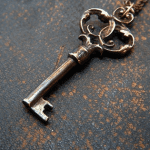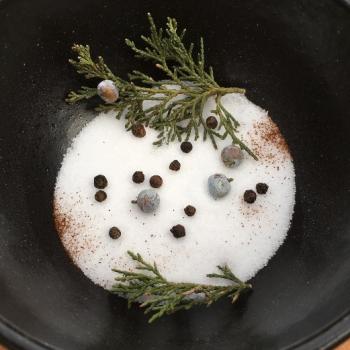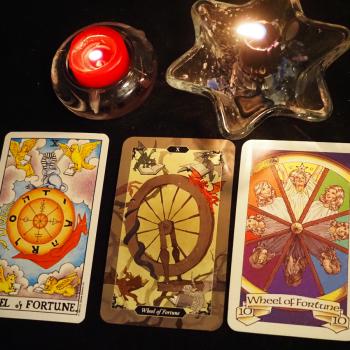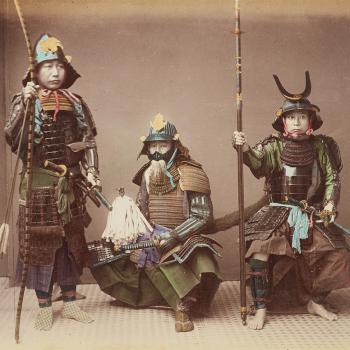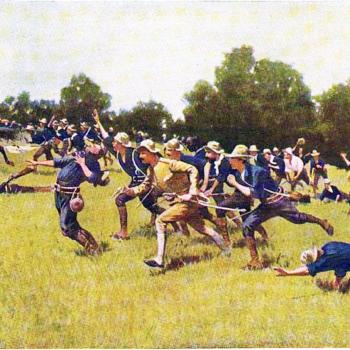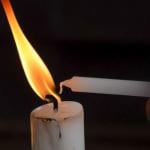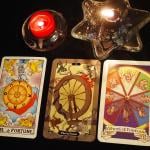So I’m pretty much in the bullseye of the target demographic for YouTube Red’s new Cobra Kai series, which continues the story of the 1984 classic film The Karate Kid and its sequels. Not only am I an 80s kid, I’m a karate teacher who sometimes quotes Mr. Miyagi to his students.
(And coincidentally, series stars William Zabka and Ralph Macchio did a promotional photo shoot at the Manhattan headquarters of my karate style. You can see those photos at Adweek. I’ve trained on that floor, changed in that locker room.)
I was nervous about them messing with an iconic story. But — other than the awkward final few minutes of the final episode, trying to set up a second season — it’s pretty good. A little on the nose at times, a little self-aware here and there, but all in all respectful of its source material and a worthy watch.
And brings up some points about masculinity that are highly relevant to the moment.
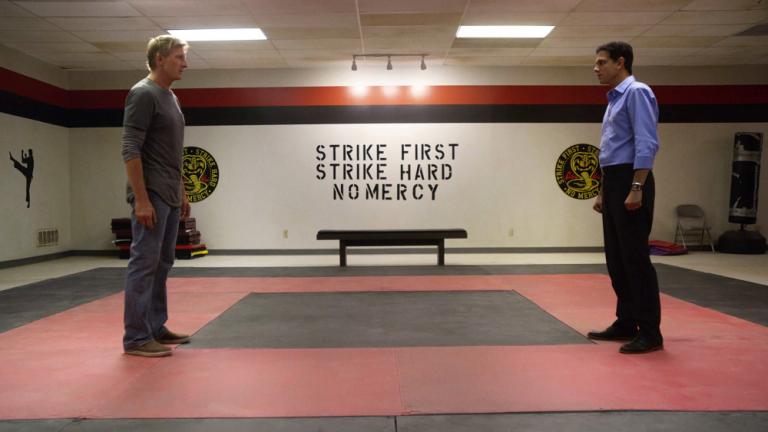
(Spoilers ahead for the first season of Cobra Kai. And also for the Karate Kid movies, but, c’mon, it’s been decades.)
The Backstory
In the original film, Jersey teen Daniel LaRusso (Ralph Macchio) moves to Los Angeles, and gets bullied by a group of locals. Pre-eminent among his tormentors is rich kid Johnny Lawrence (William Zabka), a student at the “Cobra Kai” karate dojo, a brutal training hall where Sensei John Kreese’s students chant their dojo kun: “Strike hard, strike first, no mercy, sir!”
The maintenance man at Daniel’s apartment complex, Mr. Miyagi, happens to be from Okinawa and a karate expert; he intervenes in the bullying. He convinces Kreese to have his students lay off the bullying, and for the youths to take their dispute to the upcoming All-Valley Under 18 Karate Championship. (Sure, that’s not exactly realistic, but the central convention of the sports movie genre is that the competition — the Big Game, the Championship Tournament, the Brawl To Settle It All — becomes the proxy and master key for all the protagonist’s problems.)
Mr. Miyagi then starts training Daniel for the tournament; that training is the heart of the film.
Of course the final match comes down to Daniel and Johnny, and thanks to the famous “Crane Kick” Daniel emerges victorious. Getting up off the mat, Johnny tells Daniel “You’re all right!” — typical behavior of a bully who has been bested.
In a scene originally scripted for the end of the film but which became the start of the sequel, we see Johnny being berated by Kreese for losing. Kreese assaults Johnny, but Miyagi intervenes, calmly defeating his larger and more aggressive attacker with a mostly evasive strategy.
With Kreese helpless on his knees, Miyagi quotes Kreese’s own aggressive “no mercy” philosophy, pulls back his arm as if to deliver a death blow — and then, showing the affinity of the Warrior with the Trickster, tweaks Kreese’s nose and walks away.
And that’s the last we see of Johnny in the original film franchise.
What Ever Happened to Johnny The Bully?
Cobra Kai catches up with him 34 years later; though in many ways he’s still stuck in the 80s.
On the edge of alcoholism, Johnny is just getting by working as a handyman — a shadow, perhaps, of how Mr. Miyagi was the handyman at Daniel’s apartment complex — though he soon loses that job. He’s estranged from his own son, and doesn’t seem to have grown as at person at all in the decades since we last saw him.
He is still haunted by his defeat in the tournament, seeming to regard it as the moment when his life started to go off the rails.
When his young neighbor Miguel Diaz is being beaten by a group of bullies, Johnny intervenes — not so much because out of concern for Miguel, but because the bullies throw Miguel into Johnny’s car.
Just as Daniel asked Mr. Miyagi to teach him karate after Miyagi has saved him from a gang attack, so Miguel asks Johnny. Johnny refuses at first; but after a chance encounter with Daniel, now a successful car salesman (a path perhaps rooted in the collection of classic cars Mr. Miyagi has Daniel wash and wax in the original film), Johnny decides to start teaching and re-opens the Cobra Kai.
It’s noteworthy that the series makes Johnny the protagonist. In a 2007 interview, Zabka spoke about his iconic villain,
The thing is about Johnny’s character is that he wasn’t really wrong in his point of view. He had a legitimate reason for going after his character (Danny). He took his girlfriend and he used the tools that he knew. So he wasn’t all bad. That makes him kind of special. He’s human.
…
A lot of people, when they approach a bully role, they think, “I’m the bad guy”, but I think the key to being a good bad guy is to look at yourself as the hero. So where if the movie was told from your point of view, you’d actually be the good guy.
This series is Zabka’s chance to do just that. He’s retconned into being not just a spoiled rich kid, but the stepson of a rich man who had nothing to offer him but money; he seems to carry a weight that his mother sacrificed her chance for real love in order to marry someone who could provide materially for him.
He was in search of a true father figure, just as Daniel had been; but rather than someone like Mr. Miyagi, he found Kreese and the Cobra Kai.
Strike Hard, Strike First, No Mercy
And we get more of a look at the training methods of the Cobra Kai. Johnny berates Miguel, throwing his asthma inhaler against the wall. He ties his hands and throws him into a pool, to force him to learn to kick strongly. He stands him in front of a pitching machine until he can block the hurtling baseballs rather than be struck by them. He has students line up to get punched in the face. He has Miguel do all the menial work at the dojo, scrubbing the toilet on his hands and knees. And he beats him up, over and over.
But like Daniel and Johnny years before, Miguel is a boy in search of a father. In a recent interview, Zabka says, “[I]t’s a story about a boy who needs a mentor, needs a father, and he’s got all the odds against him. Everybody wants a Miyagi in their life, a magical man who has the secrets and leads you on a path that you don’t know.”
Desperate to find that, Miguel sticks with the training. And he learns, and gets strong. He gives the bullies who tormented him and others a sound thrashing, and gains the confidence to ask his crush out on a date.
Because the tricky thing about the Cobra Kai way, is that it’s not really wrong. It does get results. It’s just incomplete.
Let me bring this back to real life karate for a second. If the brutal training methods of the Cobra Kai seem unrealistic, consider an incident from the career of real-life karate master Sei Shihan Christopher Caile. When Caile was training with the Kyokushin-kai — the ancestor style of the one that I study — in Japan in the early 1960s, he once was kicked in the head and knocked out in a sparring match with Sensei Kenji Kurosaki. The kick broke two teeth and knocked out two more.
This was not in competition, mind; this was during regular training.
But that’s not the extraordinary thing. Caile saw a local dentist, who wired the two teeth back into place. The next day, Caile showed up for class, and — hoping to avoid further injury — told his sparring partner about his jaw being wired together. Rather than avoiding the injured site, his partner promptly hit him in the same spot, and told him “Never tell your weaknesses to your opponent.”
Like the fictional Cobra Kai, the real-life Kyokushin-kai (as it existed at that time) had a method and philosophy that wasn’t wrong. Its founder, Mas Oyama, was called “the God-Hand” for his power; on several occasions he killed bulls with his bare hands. His karate was so amazing they made comic book characters (the manga Karate Baka Ichidai) out of him and his students. He built a worldwide system that still trains students today, and he basically invented full-contact karate competition.
But his philosophy was incomplete. (I believe the style has matured since then; I’m not trying to denigrate our Kyokushin-kai friends.) It was a way to make strong people stronger, but if you showed up to a Kyokushin-kai dojo and weren’t already strong, you’d be lucky to survive, much less thrive.
It’s a question of balance — something which Mr. Miyagi emphasized to Daniel at the start, and Daniel emphasizes to his student in the new series. (Yes, of course Daniel ends up with a student of his own, who has a face-off with Miguel.)
Balancing Yin and Yang
Indeed, the real-life style that is portrayed in The Karate Kid (and which is one of the ancestors of Kyokushin-kai) is Goju-ryu, the “hard-soft school”, whose very name suggests a balance of opposites.
Hard and soft have a yang and yin relationship. This element of Taoist philosophy, of interdependent and transforming opposites, may be the key we need to move towards a healthier and more mature idea of the masculine.
Yin and yang (or in and yo in Japanese) are complementary principles which manifest in all things. While yin and yang are opposites, they are also interdependent. They transform into each other, consume and support each other, and are relative rather than absolute.
Yang is the principle that is warm, bright, hard, assertive, and rising; yin is the principle that is cool, dark, soft, receptive, and descending. Day and night, fire and water, sky and ground, male and female, time and space, energy and matter, action and inaction, movement and structure, growth and decay, wakefulness and sleep, anabolism and catabolism, the sympathetic and parasympathetic nervous systems, independence and interdependence…we could go on naming yang and yin pairs forever.
In traditional East Asian medicine, a human being is seen as a manifestation of the interplay of yin and yang, and for health there must be proper balance. This doesn’t mean that yin and yang must be at the same level; it means their level relative to each other must be balanced for the individual and their circumstances.
There are two ways that yin and yang can get out of balance: one may have too much of one principle, or not enough of one. This is often referred to as “excess” or “deficiency” of the affected principle.
What we see in the Cobra Kai — what we see in much of our culture — isn’t an excess of yang. It’s not that the yang energy of masculinity is “toxic”, as is often said these days, and needs to go away. The problem is that there is not enough yin to balance it.
The more yang one cultivates, the more one needs to cultivate yin to balance it. (The converse is also true, which could be a jumping-off point for a tangent on the important topic of women in the martial arts; but let me punt that for now.)
It’s why in cultures around the world we find the idea of the “warrior poet”, why the samurai practiced Zen, and why chivalry went hand-in-gauntlet with courtly love. It’s why Mr. Miyagi is a bonsai gardener, carefully trimming the small delicate trees.
But Johnny — at least, as we first see him here — is definitely not in touch with the receptive, grounding, subtle energies of yin. If he was, he might still use many of the same rough training methods; the point is not that he has to lose or get rid of something. But with an infusion of yin, he would use them more appropriately, helping each student to slowly grow to their own limits rather then brutally weeding out those who came in weak. He would be receptive to the needs to each, rather than aggressively trying to mold them.
He would be nurturing their varied potentials, rather than trying to live vicariously through them to get free of a haunting failure.
If the series is successful enough for a second season, maybe we’ll see him grow in that way; or maybe the series will veer off into more standard issue teen drama fare. Either way, this first season is worth watching, especially if it prompts some thought and discussion about how we can move to a more mature idea of the masculine.
You can keep up with “The Zen Pagan” by subscribing via RSS or e-mail.
I will be presenting at the Free Spirit Gathering in Darlington, MD in June, and the Starwood Festival in Pomeroy OH in July. Hope to see you there. (You might even see me practicing karate in front of my tent.)





